Nuggets of News Blog
|  |
Tuesday, October 17 2023
In the words of Tom Massie, son of the late George "Buzzard" Massie who founded Gold Prospectors Association of America... "my favorite way of prospecting is the way that gets me gold."
Suction dredging with a wetsuit can be quite lucrative— not only from the material you suck up but there's also the chance of picking  nuggets out of a crack in the bedrock. Highbanking along the shore is a bit warmer and dryer, but just as fun. As is gold panning in a stream. Drywashing out in the desert surrounded by sunshine and solitude definitely has appeal. And so does uncovering buried treasure while metal detecting. And don't forget melting or smelting cell phone parts or old jewelry and coins. No matter your favorite way of finding gold, one thing is for certain, there's nothing quite like getting out there— in the field or in the water— and getting your share! nuggets out of a crack in the bedrock. Highbanking along the shore is a bit warmer and dryer, but just as fun. As is gold panning in a stream. Drywashing out in the desert surrounded by sunshine and solitude definitely has appeal. And so does uncovering buried treasure while metal detecting. And don't forget melting or smelting cell phone parts or old jewelry and coins. No matter your favorite way of finding gold, one thing is for certain, there's nothing quite like getting out there— in the field or in the water— and getting your share!
SIZES OF GOLD:
- Specimen: A naturally formed large gold nugget or gold-laced quartz specimen
- Nugget: A naturally formed lump of gold that is big enough to put in a poke and likely won't fit in a typical small vial, depending on its shape
- Picker: A piece of visible gold large enough to easily pick up with your fingers
- Flake: A piece of gold that is large enough to easily spot but is difficult to pick up with your fingers
- Fines: Particles of gold too small to pick up with your fingers
- Gold Dust: Very, very fine particles of gold that resemble dust
- Flour: Gold particles that are barely visible to the naked eye
- Micron Gold: Particles that are invisible to the naked eye
- Color: Any amount of visible gold - usually smaller than a nugget - that you find in your pan
Tuesday, May 23 2023
Garrett has announced a new promotion for summer 2023 — buy the Ace 300, Ace 400, or Ace Apex metal detector and get a Pro-Pointer pinpointer for a LOW price! Big savings over purchasing the detectors and pinpointers separately! LIMITED TIME OFFER WHILE SUPPLIES LAST.... or until Garrett says it's over!
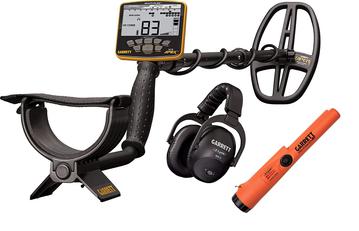
ACE 300 SPECIAL - Includes an ACE 300 detector + AT PRO-POINTER for $369.95 — SAVE $27.95 compared to purchasing each item separately.
ACE 400 SPECIAL - Includes an ACE 400 detector + AT PRO-POINTER for $459.95 — SAVE $25.95 compared to purchasing each item separately.
ACE APEX SPECIAL - Includes an ACE APEX detector + wireless PRO-POINTER AT Z-LYNK for $555.93 — SAVE $86.97 compared to purchasing each item separately.
Tuesday, February 14 2023
There are a variety of searchcoil sizes and shapes and configurations. The correct one to use depends on the environment it will be used in as well as the targets being sought. A change in any one of these variables may require a different searchcoil. Sometimes changing the search coil on your metal detector is the next best thing to buying a whole new machine! It is possible that merely changing the coil on your detector will lead you to a host of new targets. used in as well as the targets being sought. A change in any one of these variables may require a different searchcoil. Sometimes changing the search coil on your metal detector is the next best thing to buying a whole new machine! It is possible that merely changing the coil on your detector will lead you to a host of new targets.
CONFIGURATIONS
In addition to searchcoil sizes and shapes, there are also a variety of searchcoil configurations available, with each proving to be the best choice depending on hunting applications and ground conditions. The configuration of a searchcoil refers to the arrangement of the Transmit Coil (TX) and Receive Coil (RX) within the searchcoil shell. The most common configurations are: Concentric, Mono, Imaging, and Double-D.
Concentric
The concentric configuration consists of a TX coil and RX coil which are usually circular. The advantage of this configuration is that both the TX and RX coils are wound as large as possible within a given searchcoil diameter. This provides the largest possible detection fi eld and greatest detection depth, making the concentric coil potentially the most sensitive confi guration available. In addition, concentric coils also provide the most symmetrical detection field, allowing ease in pinpointing and consistency in target identification. For these reasons, they are the most commonly used searchcoil and will provide the best overall performance in most environments. Unfortunately, this configuration is the most susceptible to interference from ground minerals, which results in substantial loss of performance when used over heavily mineralized ground.
Mono
A mono-coil is available only on Pulse Induction detectors, such as Garrett's new Axiom Metal Detector, and is a variation of the concentric configuration. The mono-coil can be manufactured with the TX and RX coils located together or as a single coil acting as both TX and RX. The detection and performance characteristics of the mono are essentially the same as the concentric in that it provides the maximum possible sensitivity, but suffers some performance in mineralized ground.
Imaging
An Imaging searchcoil is an enhanced version of the concentric configuration that features an additional RX coil. This extra coil provides the detector with additional target information necessary for true target-depth perception and true target-sizing capabilities. With this additional sizing information, the detector can more fully characterize a target and for the first time distinguish between trash and good targets of the same conductivity (e.g. a quarter vs. a soda can). Only the Garrett GTI metal detector offers this technology.
DD Search coils have two smaller “D” shaped coils housed inside to penetrate heavily mineralized ground that is commonly encountered while gold prospecting and relic hunting. The Double-D configuration is designed to 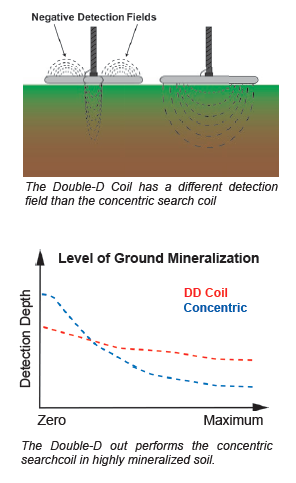 significantly reduce ground interference and, thereby, recover the performance lost by a concentric coil over mineralized soil. With the Double-D, it is the arrangement of the TX and RX coils that produce a canceling effect of ground signals. This configuration is called DD because both TX and RX coils are in the shape of a “D”. The positive detection fi eld of the DD runs beneath the overlapping center section from front-to-back. The remaining portion of the coil actually produces negative (i.e. canceling) detection fields. It is this canceling field that allows the DD coil to maintain performance over mineralized ground. Because of its small positive detection field, the DD is inherently less sensitive than a concentric searchcoil of the same size, over non-mineralized ground. The Double-D will, however, significantly outperform the concentric coil over mineralized ground. For this reason, it is highly recommended when hunting over mineralized ground commonly found when prospecting and relic hunting. significantly reduce ground interference and, thereby, recover the performance lost by a concentric coil over mineralized soil. With the Double-D, it is the arrangement of the TX and RX coils that produce a canceling effect of ground signals. This configuration is called DD because both TX and RX coils are in the shape of a “D”. The positive detection fi eld of the DD runs beneath the overlapping center section from front-to-back. The remaining portion of the coil actually produces negative (i.e. canceling) detection fields. It is this canceling field that allows the DD coil to maintain performance over mineralized ground. Because of its small positive detection field, the DD is inherently less sensitive than a concentric searchcoil of the same size, over non-mineralized ground. The Double-D will, however, significantly outperform the concentric coil over mineralized ground. For this reason, it is highly recommended when hunting over mineralized ground commonly found when prospecting and relic hunting.
It’s important to know the benefits of using various size, shape and configurations of coils because simply changing the search coil on your metal detector is the next best thing to buying a whole new machine! Garrett is the global leader of ground search metal detectors, pinpoints, coils, and other accessories. Browse Garrett detectors and more.
Part 1 covered search coil size, shape and depth.
Monday, February 13 2023
The searchcoil is a vital part of your metal detector. It generates a magnetic field and senses metallic targets in the surrounding environment. The size and depth of the magnetic field is determined by the shape and size of the searchcoil. Understanding the purposes behind the various sizes and shapes of searchcoils will empower you with the ability to choose the best coil for each application.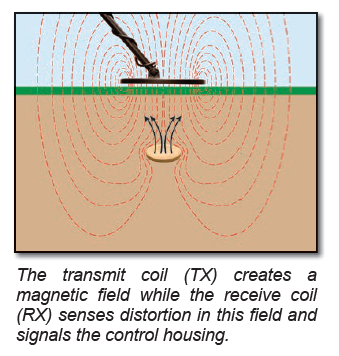
HOW SEARCHCOILS WORK
Searchcoils generally consist of two internal sets of coiled wires, a Transmit Coil (TX) and a Receive Coil (RX). Mono coils can be different in that one coil acts as both the TX and the RX. When the detector is turned on, the TX coil generates a magnetic field in the surrounding space. When a metallic object is within this generated magnetic field, it will create a distortion in the magnetic field. The RX coil will sense this distortion and send a signal to the control housing. A searchcoil’s detection pattern is determined by the combination of the TX’s generated field pattern and the RX’s sensing field pattern.
SEARCHCOIL DEPTH
The detection depth of a searchcoil, as a rule-of-thumb, will be approximately equal to its diameter, for a coin-sized object. However, as a searchcoil’s size increases and its field pattern becomes larger, the field pattern becomes less concentrated and begins to miss small objects. For a coin-sized object, this effect becomes noticeable when using searchcoils larger than about 15" in diameter. Since the field generated by a large searchcoil is larger, deeper and less concentrated than a small searchcoil, it is the best choice when hunting for targets that are usually large and deeply buried, such as caches or relics. there is a direct relationship between the size of a magnetic fi eld and the size of a coil. The bigger the coil, the larger the magnetic fi eld. Therefore, larger searchcoils generally detect deeper than smaller searchcoils.
SEARCHCOIL SIZES
- Smaller Search Coils (less than 6" in diameter): Great for “trashy” areas, really allowing you to sift through metal debris. These coils are best for tighter places and the smallest, shallow targets. Because the magnetic field of a small search coil is concentrated within a small volume, it is the best choice for hunting in areas with a lot of metal debris. This allows you to maneuver through and around trash to locate good targets, especially when searching in tight places where large searchcoils cannot go. In addition, because of their concentrated detection field, small searchcoils are the best for detecting very small objects. However, a small searchcoil provides less coverage per sweep; more scans will be required to cover a search area.
- Medium Search Coils (6-11" in diameter): Usually come standard with your metal detector, medium search coils are designed for general use in finding the broadest range of targets in the broadest range of environments. For general-purpose hunting, which typically includes coins and coin-sized targets, a medium sized searchcoil (8 - 9") is the best choice. Because a medium sized searchcoil provides the best combination of magnetic field concentration, detection depth and capability to detect the greatest range of target sizes within the detection area, it is standard with most detectors. In addition, it’s lightweight and easy to maneuver.
- Large Search Coils (over 11" in diameter): The larger the search coil, the deeper it will penetrate the ground. Great for finding caches or relic hunting, finding deeply buried, large targets. Large searchcoils generate wider and deeper magnetic fields than small coils and consequently provide greater depth and coverage. This means that scanning a search area requires fewer sweeps with a large searchcoil than with a smaller coil. This larger scan area, however, can become a problem in trashy areas where the search coil is detecting several targets at once.
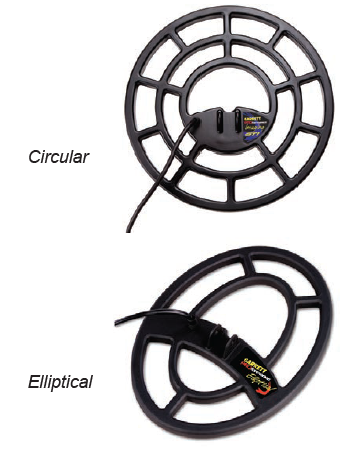
SEARCHCOIL SHAPES
Generally, search coils are circular or elliptical in shape. An elliptical searchcoil is more maneuverable than a circular searchcoil and its narrow width actually provides greater coverage than a circular coil due to its elongated length. However, a circular searchcoil has slightly more detection depth and sensitivity in non-mineralized soil, so it is still the most commonly used shape.
It’s important to understand the pros and cons of using various size, shape and configurations of coils because simply changing the search coil on your metal detector is the next best thing to buying a whole new machine! Most metal detectors come with a standard search coil that is good for general use – finding the broadest range of targets in the broadest range of environments. But search coils come in all shapes and sizes, and it's possible that merely changing the coil on your detector will lead you to a host of new targets in that “hunted out” area.
Garrett is the global leader of ground search metal detectors, pinpointers, coils, and other accessories. Browse Garrett detectors and more.
Part 2 — search coil configurations
Wednesday, February 08 2023
Grab your Garrett metal detector and accessories and head to Canton, Texas, April 14-16 for their Memorial Hunt! Ti cket registration for the Garrett Memorial Hunt closes in less than a month, and with over $100,000 worth of prizes, you don't want to miss out. The more hunters who sign up, the more this value will increase! Tickets are limited, so be sure to secure your spot before they sell out. Sign-ups end March 1, 2023! cket registration for the Garrett Memorial Hunt closes in less than a month, and with over $100,000 worth of prizes, you don't want to miss out. The more hunters who sign up, the more this value will increase! Tickets are limited, so be sure to secure your spot before they sell out. Sign-ups end March 1, 2023!
Details:
Friday, April 14, through Sunday, April 16 in conjunction with Texas Association of Metal Detecting Clubs (TAMDC). The event will be held at:
First Monday (flea market grounds)
800 First Monday Lane
Canton, TX 75103
Basic Hunt Package:
- One hunt package fee covers all Garrett events!
- Participation in several prize hunts
- One Garrett Memorial Hunt T-shirt (if the hunt fee is paid before the deadline).
- Free First Monday park admission and tent camping (RV camping requires an additional fee).
- Hunters are free to search throughout the designated park grounds for native coins and relics.
- Additional details, hotel information, etc. found here.
Plenty of Fun for All Ages!
- Meet other treasure hunters and find some treasure! Or explore Canton's historic district and local museums.
- Free Kids Hunt for ages 12 and under.
- All prizes will be awarded! A random drawing will be conducted for unclaimed prizes.
- Treasure talk on Saturday by Jase Robertson, star of Duck Family Treasure TV show!
- Picnic and coolers allowed. Concessions available in Civic Center building on Saturday and Sunday.
Whether it's time to buy your first Garrett metal detector, an upgraded model, or additional coils, headphones, carry bag or other accessories, check out the selection of Garrett treasure hunting items here.
Thursday, April 28 2022
Over the years, metal detecting has continued to become one of the most popular forms of gold prospecting, especially with folks new to prospecting. Panning, sluicing, and highbanking can be lucrative ways to recover the shiny stuff, but when you’re first bitten by the gold bug, you might opt for the simplest, quickest approach — swinging a detector. Not only is it physically easier than processing heavy dirt and rock, it offers the added bonus of finding more than just gold, such as coins, jewelry, relics, and other buried metallic treasures, too. Aside from record gold prices, another reason that people are eager to try metal detecting i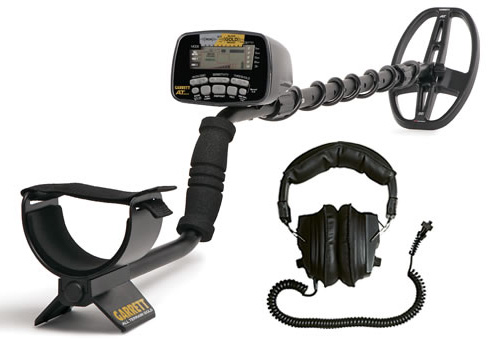 s because it gets you out of the house and away from crowds. It’s a fun hobby you can do with your family surrounded by fresh air! s because it gets you out of the house and away from crowds. It’s a fun hobby you can do with your family surrounded by fresh air!
The basic premise of metal detecting is allowing the detector to introduce an energy field into the ground, and allowing that field the opportunity to return any target information that it finds via the detector’s control box. The two most common types of metal detectors to consider:
VLF (very low frequency) metal detectors are the most common type of detector. They work by sending out energy that is either reflected off or conducts through an object containing metal. The device then measures how long it takes for the signal to return. Frequency refers to how fast a metal detector sends signals into the ground. As the name indicates, these detectors use very low frequency coils (generally below 30 kHz.) The outer coil serves as the transmitter and the inner coil serves as a receiver.
PI (pulse induction) metal detectors send energy into the ground and measure the decay of that signal. Anything that slows or speeds the decaying signal is a target. This technology sends powerful, short bursts (pulses) of current through a coil of wire. Each pulse generates a brief magnetic field. When the pulse ends, the magnetic field reverses polarity and collapses very suddenly, resulting in a sharp electrical spike. This spike lasts a few microseconds (millionths of a second) and causes another current to run through the coil. This current is called the reflected pulse and is extremely short, lasting only about 30 microseconds. Another pulse is then sent and the process repeats.
Generally speaking, the higher the price of a metal detector, the more features it will have. More features translate into more knobs. The more features and/or knobs that a detector has, the more you are able to tune the metal detector to the type of hunting conditions that you are likely to encounter. With that being said, the downside to a large number of features is that even though you are able to fine tune the detector to match the local conditions, there are also more ways of setting up the detector incorrectly. Setting up a machine "wrong" may result in a decrease in depth and sensitivity and your $900 metal detector may be outdone by a $200 model! It is critical to read the owner’s manual that comes with your detector and learn to use it properly for maximum results. Keep in mind when shopping for a detector that gold detectors are not necessarily higher in cost, but they are built with a higher sensitivity to detecting gold nuggets, have better ground balancing and discrimination abilities, and could be the best option for you.
The #1 question that everyone asks is “What is the best metal detector?” Unfortunately, there is no one single answer. Each metal detectorist has specific needs that cannot be met by one single detector. The easiest way to find the "best" detector is to evaluate YOUR detecting style, your experience level, what items you hope to find, and the time that you will spend metal detecting. After taking all of these things into consideration, then you will be able to find a metal detector that fits your needs and your budget.
If you’re wondering how deep a detector can detect, realize that there are too many variables to be able to unequivocally quote a depth for any particular brand or model. The size of the target, how it is positioned, ground mineralization, ground moisture, and more are just some of the factors that affect the depth of a detector.
When treasure hunting with your detector for coins, relics, or jewelry, use your imagination as to where to hunt — anywhere people are likely to have lost something or left something behind is a likely place to dig up good finds—playgrounds at schools and parks, picnic areas, campgrounds, new construction sites, ghost towns, old homesteads, woodlands, plowed fields and pastures, sports fields, showgrounds, and racetracks, swimming holes, beaches, jetties, and piers. Right under your feet might be a good place to start; you never know what you'll find in your own backyard! Remember to always know local laws before using your metal detector. Many state and national parks and historic sites do not permit detecting. Be sure to first ask permission to treasure hunt on private property.
If you want to get out there this year and get your share of the gold but the idea of panning, sluicing, highbanking, or using another piece of gold mining equipment just isn't your idea of fun, that's OK. Consider a metal detector instead. Since the lure of uncovering a gold nugget of any size is addictive, you'll see people in known gold bearing areas swinging a detector, listening intently through their headphones for that magic tone that says DIG. Go ahead and join the fun! Today it is easier and more productive than ever to go treasure hunting. The metal detecting hobby has gone to a whole new level using state of the art technology that makes metal detecting equipment more high tech than ever.
Monday, March 15 2021
Spring is in the air, and Garrett is making it a little easier on your wallet to get out there and start swinging a new metal detector! For a limited time, Garrett is offering two specially-priced packages. Each package includes a metal detector, headphones, an AT Pinpointer, and Garrett Edge Digger. You save $134.90 on a package as compared to buying each component separately. Both packages have FREE SHIPPING, too!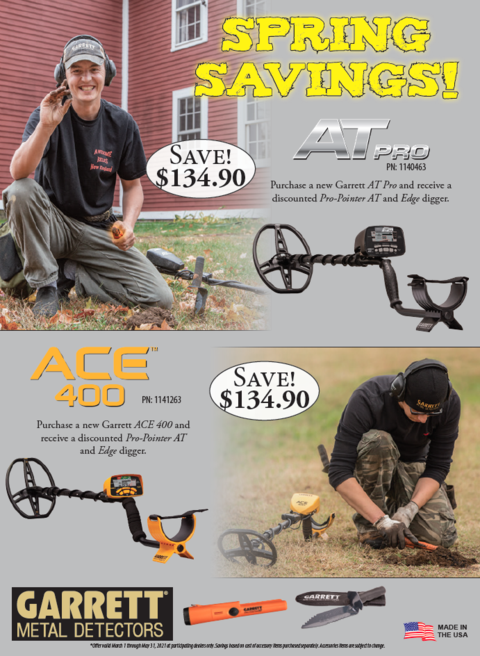
Garrett AT Pro Metal Detector and Headphones. The AT Pro is Garrett's all-terrain, all-treasure, deep-seeking, professional treasure hunter's detector! This all-terrain detector offers new and exclusive Garrett technology that makes highly recommended for Coin Hunting, Jewelry Hunting, Relic Hunting, Cache Hunting, Prospecting, Ghost Town Hunting, Competition Events, Beach/Fresh Water Hunting. Select from either Standard or Professional search modes with enhanced audio features. The AT Pro was designed to work in challenging environments such as mineralized ground, high trash areas, wet and humid areas and dust. In fact, the entire metal detector can be submerged under water to a dept of 10 feet, so it's an excellent choice for detectorists who might also be gold prospectors working in streams, ponds, or shallow water off the shoreline. Includes upgraded MS-2 headphones, Pro-Pointer AT Pinpointer and Garrett Edge Digger. Details on AT Pro Spring 2021 package here.
Garrett ACE 400 Metal Detector and Headphones. The top of the ACE family, the 400 has a new Iron Audio feature, a powerful DD coil, a higher frequency, and volume control headphones. Its advanced features make the ACE 400 powerful on coins, jewelry, and artifacts. Features a 8.5” x 11” PROformance DD submersible searchcoil. Comes with Pro-Pointer AT Pinpointer, Garrett Edge Digger, and ClearSound Easy Stow Headphones that feature padded ear pieces, 41 inch coiled cord extends to 82 inches, and 1/4 inch phone plug. Details on ACE 400 Spring 2021 package here.
Metal Detectorist Code of Ethics
- Always check federal, state, county and local laws before using your metal detector. It is your responsibility to “know the law.”
- Abide by all laws, ordinances or regulations that may govern metal detecting in the area you will be in.
- Never trespass. Always obtain permission prior to entering private property, mineral claims, or underwater salvage leases.
- Do not damage, deface, destroy, or vandalize any property (including: ghost towns and deserted structures), and never tamper with any equipment at the site.
- Never litter. Always pack out what you take in, and remove all trash your metal detector uncovers during your search.
- Fill all holes, regardless how remote the location, and never dig in a way that will damage, be damaging to, or kill any vegetation.
- Do not build fires, camp or park in non-designated or restricted areas.
- Leave all gates and other accesses to land as found.
- Never contaminate wells, creeks, or any other water supplies.
- Be courteous, considerate, and thoughtful at all times when metal detecting.
- Report the discovery of any items of historic significance you find with your metal detector to the local historical society or proper authorities.
- Uphold all finders, search and salvage agreements.
- Promote responsible historical research and artifact recovery, and the sharing of knowledge with others.
Friday, December 02 2016
Metal detectors are electromagnetic devices and can detect items that are conductive or magnetic, or both. Gold is an example of a non-magnetic conductive item. Iron is both conductive and magnetic. Almost all major advances in prospecting metal detectors over the last 40 years revolve around improving ways to ignore and see through ground mineralization while still finding gold nuggets. If you’re using any brand of VLF (very low frequency) metal detector to prospect for gold, choosing the correct operating mode (also called search mode) can make or break your success.
Experts recommend that any metal detector you are considering for gold prospecting should have a true all metal mode. This mode is important because of its lack of filtering applied to the signal. It will normally offer the best depth and the best sensitivity to small gold. Unfortunately, two common problems occur when using All Metal Mode: interference from ferrous iron and steel junk, and from hot rocks. A hot rock is nothing more than a rock that has a different magnetic content than the ground. Some rocks are that way because they contain conductive minerals besides gold. The Discrimination knob on your detector will help with these two problems.
Discrimination is a type of electronic filtering. The signal is analyzed, and depending on the discrimination setting, identified as either a target to be dug or a target to be ignored. Applying more discrimination eliminates more trash, but be careful—you don’t want to completely eliminate all ferrous trash because an aggressive level of discrimination easily tunes out gold. So be prepared to still dig ferrous junk which usually turns out to be larger chunks of steel and iron. Also know that discrimination circuits can be fooled, especially in ground with lots of iron mineralization. This ground condition can override the small gold signal and cause a faint gold signal to be identified as ferrous. Even with this limitation, the discrimination mode can be invaluable for finding gold in extremely trashy areas. Trashy areas are where a VLF detector can really outshine a PI (pulse induction) machine, especially when dealing with nails, bits of rusted cans, and other small trash. If you’re in the market for a metal detector, some manufacturers offer special holiday packages such as the 3 listed below. You can also shop for Fisher, Garrett, Bounty Hunter, Minelab, Tesoro and Teknetics metal detectors here.
Through Christmas only... FREE Recharge Kit and FREE 15” Coil and FREE Shipping with purchase of either Fisher F75 ($599) or Teknetics T2 ($499) detectors! Both machines are recommended for Coin Shooting, Relic Hunting, and Gold Prospecting.
 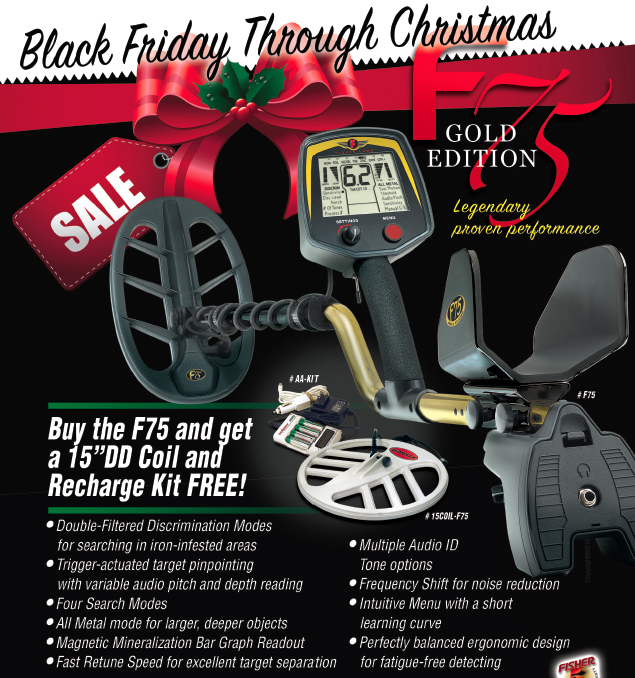
Garrett AT Pro holiday package ($594.96) includes detector, headphones, instructional DVD,
backpack, digger pouch, cap, and coil cover and also SHIPS FREE!
Monday, June 27 2016
In case you hadn't heard the exciting news... Garrett recently introduced three new detectors in the ACE series— the 200, 300 and 400! Each of the new ACE detectors include Digital Target ID—a large, 100-digit target information display for better target identification—as well as a more robust audio package, and stem locks for additional strength and stability. With the great pricing and features, it's no wonder that all three detectors have proven to be fast movers as soon as they hit the market!
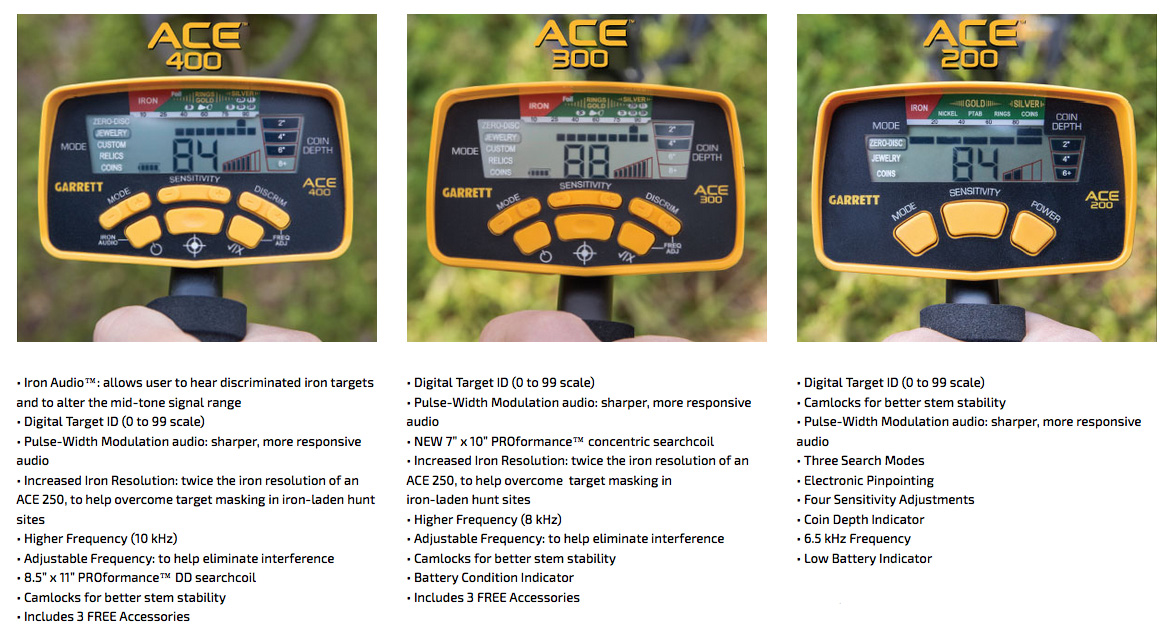
 The new flagship of the ACE lineup is the ACE 400 ($339.95) which features the Iron Audio feature made popular on the much more expensive AT Pro and AT Gold detectors. Iron Audio allows users to hear discriminated iron and to alter the detector’s mid-tone signal range. This helps you to hear the iron content in flat steel objects like bottle caps and washers that sometimes trick a detector into reporting them as good targets. The ACE 400 opeartes at a 10 kHz frequency to provide better sensitivity to low and medium conductivity targets, such as gold and lead. The detector’s Frequency Adjust feature allows users to easily toggle between slight frequency shifts to help eliminate interference from other detectors or power sources. The ACE 400 ships with an 8.5”x11” DD-configuration PROformance search coil that has proven to be very popular on other Garrett models. The ACE 400 includes five discrimination modes, electronic pinpointing, sensitivity adjustment, and High-Resolution Iron Discrimination, and is ideal for oins, jewelry, relics,dry beach, fresh water wading, competition events, cache The new flagship of the ACE lineup is the ACE 400 ($339.95) which features the Iron Audio feature made popular on the much more expensive AT Pro and AT Gold detectors. Iron Audio allows users to hear discriminated iron and to alter the detector’s mid-tone signal range. This helps you to hear the iron content in flat steel objects like bottle caps and washers that sometimes trick a detector into reporting them as good targets. The ACE 400 opeartes at a 10 kHz frequency to provide better sensitivity to low and medium conductivity targets, such as gold and lead. The detector’s Frequency Adjust feature allows users to easily toggle between slight frequency shifts to help eliminate interference from other detectors or power sources. The ACE 400 ships with an 8.5”x11” DD-configuration PROformance search coil that has proven to be very popular on other Garrett models. The ACE 400 includes five discrimination modes, electronic pinpointing, sensitivity adjustment, and High-Resolution Iron Discrimination, and is ideal for oins, jewelry, relics,dry beach, fresh water wading, competition events, cache
hunting, and it has features for basic gold prospecting. The ACE 400 ships with three FREE accessories: a searchcoil cover; volume-control ClearSound Easy Stow headphones; and an ACE Environmental Cover-up to protect the control box from rain, dust, and mud. More details on the ACE 400 and accessories here.
 Next in the new ACE lineup is the ACE 300 ($254.95). It features a new 7”x10” concentric PROformance searchcoil for additional coverage and detection depth. The ACE 300 sports a higher frequency of 8 kHz for better sensitivity to low and medium-conductivity targets. Other features of the ACE 300 include Digital Target ID; Frequency Adjust; more Iron Discrimination segments, stem locks for added stability; and the same three FREE accessories (searchcoil cover, headphones, and cover-up) that also ships with the 400 model. The ACE 300 is ideal for coins, jewelry, relics, dry beach, fresh water wading and competition events. Can also be used Next in the new ACE lineup is the ACE 300 ($254.95). It features a new 7”x10” concentric PROformance searchcoil for additional coverage and detection depth. The ACE 300 sports a higher frequency of 8 kHz for better sensitivity to low and medium-conductivity targets. Other features of the ACE 300 include Digital Target ID; Frequency Adjust; more Iron Discrimination segments, stem locks for added stability; and the same three FREE accessories (searchcoil cover, headphones, and cover-up) that also ships with the 400 model. The ACE 300 is ideal for coins, jewelry, relics, dry beach, fresh water wading and competition events. Can also be used
for entry-level prospecting or cache hunting. More details on the ACE 300 and accessories here.
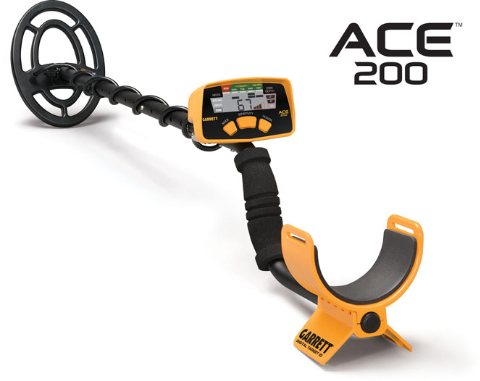 The Garrett ACE 200 is the new entry-point detector ($169.95) with a 6.5”x9” concentric PROformance searchcoil that operates on a 6.5 kHz frequency. With the quality and performance of the ACE 200, you can begin finding treasure right away—in your own backyard or wherever you travel. This detector is highly recommended for Coin Hunting, Dry Beach/Fresh Water Hunting; and recommended for Jewelry Hunting, Relic Hunting, Competition Events. More details on the ACE 200 here. The Garrett ACE 200 is the new entry-point detector ($169.95) with a 6.5”x9” concentric PROformance searchcoil that operates on a 6.5 kHz frequency. With the quality and performance of the ACE 200, you can begin finding treasure right away—in your own backyard or wherever you travel. This detector is highly recommended for Coin Hunting, Dry Beach/Fresh Water Hunting; and recommended for Jewelry Hunting, Relic Hunting, Competition Events. More details on the ACE 200 here.
It's healthy to take a break once in a while from the office, the grind, and the daily pressure— especially with great weather and long hours of daylight. Grab your metal detector and get out there— wherever your “there” might be. Take your detector along on a camping trip or on your next hike. And don't forget coin shooting in the park (kids love it!). You never know when you might encounter some long-forgotten site that’s just waiting to be hunted by YOU! Summer is the perfect season for metal detecting and the ideal time to unwind and search for your next great find! Good luck hunting!
Saturday, June 06 2015
Why buy only a metal detector when now you also get FREE accessories?! For a limited time, Garrett is offering the ACE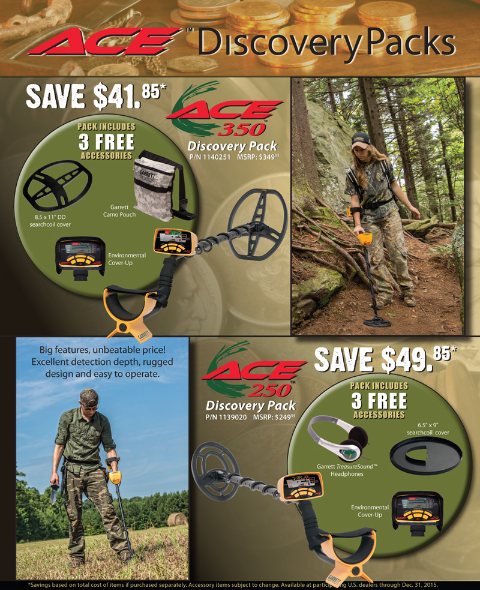 250 Discovery Pack and the ACE 350 Discovery Pack. Here's what you get FREE when you purchase either metal detector: 250 Discovery Pack and the ACE 350 Discovery Pack. Here's what you get FREE when you purchase either metal detector:
The Garrett ACE 250 metal detector (#1139070) will be shipped with 3 FREE ACCESSORIES: Garrett TreasureSound headphones with volume control (#1612500), and a 6" x 9" searchcoil cover (#1605700) and the ACE Environmental Cover-Up (#1619900). All of this for just $212.45! You SAVE $49.85 MSRP compared to purchasing the detector and three accessories individually. The ACE 250 is Highly Recommended for Coin Hunting, Competition Events, Dry Beach/Fresh Water Hunting. Recommended for Jewelry Hunting, Relic Hunting, Ghost Town Hunting.
Key Features:
- Electronic Pinpointing: to precisely locate target and speed recovery
- Accept/Reject Discrimination: to modify discrimination patterns
- Five Search Modes: select pre-set discrimination pattern or create your own
- Continuous Coin Depth Indicator: to determine target depth
- Battery Condition Indicator: shows battery life continually
- Interchangeable ACE series searchcoils: are available
- Expanded Target ID Legend: easy-to-read above large LCD screen
- Pushbutton Controls: with One-Touch operation
- Other features: 3-piece travel/storage, disassembles to 24"; adjustable arm cuff; quarter-inch (1/4") size headphone jack.
Search Modes (Discrimination Patterns): 5 plus electronic pinpointing
- All Metal (Zero)
- Jewelry
- Custom
- Relics
- Coins
- Pinpoint
Download the owner's manual, purchase, or learn more about the Garrett ACE 250 here.
The Garrett ACE 350 metal detector (#1140260) will be shipped with 3 FREE ACCESSORIES: a Garrett Camo Digger's Pouch (#1612900), an 8.5" x 11" searchcoil cover (#1606600) and the ACE Environmental Cover-Up (#1619900). All of this for just $297.45! You SAVE $41.85 MSRP compared to purchasing the detector and three accessories individually. The versatile ACE 350 includes the best features of the world-famous ACE 250 but adds a powerful new 8.5" x 11" DD searchcoil, enhanced iron discrimination, and a higher frequency. This machine is highly recommended for Coin Hunting, Jewelry Hunting, Relic Hunting, Competition Events, Dry Beach/Fresh Water Hunting. If you want to search homesites, parks, campgrounds, playgrounds, and beaches, the ACE 350 is ideal!
Key Features
- Enhanced Iron Resolution™: allows more control of iron discrimination levels; helps separate good targets from adjacent junk iron.
- Powerful new Double-D searchcoil: provides greater detection depth and performance in mineralized grounds and excellent scanning coverage.
- Higher Frequency: offers improved ability to detect both small (i.e. small gold nuggets) and large targets
- Volume Control Headphones: included with purchase
- Electronic Pinpointing: to precisely locate target and speed recovery
- Accept/Reject Discrimination: to modify discrimination patterns
- Five Search Modes: select pre-set discrimination pattern or create your own
- Continuous Coin Depth Indicator: to determine target depth
- Battery Condition Indicator: shows battery life continually
- Interchangeable ACE series searchcoils: are available
- Other features: One-Touch operation; 3-piece travel/storage, disassembles to 24"; adjustable arm cuff; quarter-inch (1/4") size headphone jack.
Search Modes (Discrimination Patterns): 5 plus electronic pinpointing
- All Metal (Zero)
- Jewelry
- Custom
- Relics
- Coins
- Pinpoint
Download the owner's manual, purchase, or learn more about the Garrett ACE 350 here.
No matter which you choose— the 250 or the 350 Discovery Pack— both detectors includes Garrett’s patented discrimination feature. This technology, found only on Garrett detectors, features two indicator scales that allow the user to see the detector’s discrimination setting (Lower Scale) as well as the analysis of each detected target (Upper Scale). Offer for FREE accessory discovery packs ends December 31, 2015. Happy Hunting!
Monday, April 27 2015
What is the best metal detector? This is probably the Number One question that everyone asks when 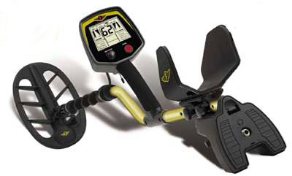 buying their first detector. No one wants to waste their time and money so they want to know what's "best" right from the start. That's understandable, but unfortunately there is no one single answer. The easiest way to find the "best" detector for YOU is to evaluate YOUR detecting style, YOUR experience level, what items YOU hope to find, and the time that YOU will spend metal detecting. After taking all of these things into consideration, then you will be able to find a metal detector that fits your needs and your budget. To make the purchasing process easier, answer these questions: buying their first detector. No one wants to waste their time and money so they want to know what's "best" right from the start. That's understandable, but unfortunately there is no one single answer. The easiest way to find the "best" detector for YOU is to evaluate YOUR detecting style, YOUR experience level, what items YOU hope to find, and the time that YOU will spend metal detecting. After taking all of these things into consideration, then you will be able to find a metal detector that fits your needs and your budget. To make the purchasing process easier, answer these questions:
How much do you know about metal detectors? Be honest because the answer also affects your budget. If you're just getting started and plan to go out just a few weekends a year, you may not want to shell out a lot of cash up front so a general all-purpose detector in the $200 range will suit your needs. If you have used a friend's detector a few times and are fairly serious about wanting to find gold and other buried treasures of your own, then buy a detector in the $700 range that is user-friendly. You will get a very good quality machine with plenty of bells and whistles, yet it won't require an advanced degree to actually use it. And you won't have to spend hours reading the owners' manual to understand it either. Before investing in a model that costs thousands of dollars, first be sure you love detecting and will use it often enough to justify the big price tag no matter what brand you decide on. Garrett and Fisher are two of the oldest manufacturers in the business.
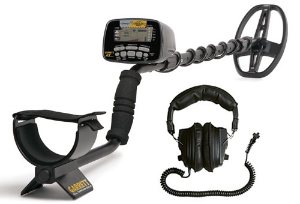 Where do you plan to detect? Deserts, rivers, parks, and saltwater beaches all have very different ground conditions. If you prefer to be in deep water, you'll want a submersible detector. If you plan to hunt around the shoreline, then you don't have to worry about the entire detector being waterproof, just the coil. If you will be in city parks and other areas where overhead power lines are the norm, then a very low frequency (VLF) detector will be your best bet. If you plan to hunt mostly in heavily mineralized areas, consider a pulse induction (PI) machine for best results. Keep in mind that just changing the search coil on your metal detector can be the next best thing to buying a whole new machine without spending a lot of money! Most metal detectors come with a standard search coil that is good for general use – finding the broadest range of targets in the broadest range of environments. But search coils come in all shapes and sizes, and it's possible that merely changing the coil on your detector will lead you to a host of new targets. Where do you plan to detect? Deserts, rivers, parks, and saltwater beaches all have very different ground conditions. If you prefer to be in deep water, you'll want a submersible detector. If you plan to hunt around the shoreline, then you don't have to worry about the entire detector being waterproof, just the coil. If you will be in city parks and other areas where overhead power lines are the norm, then a very low frequency (VLF) detector will be your best bet. If you plan to hunt mostly in heavily mineralized areas, consider a pulse induction (PI) machine for best results. Keep in mind that just changing the search coil on your metal detector can be the next best thing to buying a whole new machine without spending a lot of money! Most metal detectors come with a standard search coil that is good for general use – finding the broadest range of targets in the broadest range of environments. But search coils come in all shapes and sizes, and it's possible that merely changing the coil on your detector will lead you to a host of new targets.
What do you primarily hope to find? If you want to find gold, you'll need a detector especially made for that purpose. Gold detectors are not necessarily more expensive, but they are built with a higher sensitivity to detecting gold nuggets, and have better ground balancing and discrimination abilities. PI machines aren't so good for coin shooting in urban areas where you are likely to encounter iron trash, however, they are ideal for beaches or detecting in other highly mineralized soils, especially if you are looking for objects that are deeply buried. VLF detectors are more sensitive to finding the smallest bits of gold, but do not as easily cancel out ground mineralization.
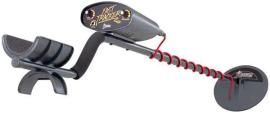 Metal detecting is one of the easiest, most profitable, and fun ways to find gold and other metallic treasures such as coins, jewelry, and relics. It's so easy to have your metal detector ready to go in its carry bag with extra coils, a digger or scoop, headphones, and spare batteries. Just grab and go! There are many thousands of passionate detectorists around the world already enjoying the rewarding outdoor activity of metal detecting. If you want to join their ranks, please keep the following in mind: Metal detecting is one of the easiest, most profitable, and fun ways to find gold and other metallic treasures such as coins, jewelry, and relics. It's so easy to have your metal detector ready to go in its carry bag with extra coils, a digger or scoop, headphones, and spare batteries. Just grab and go! There are many thousands of passionate detectorists around the world already enjoying the rewarding outdoor activity of metal detecting. If you want to join their ranks, please keep the following in mind:
Metal Detectorist Code of Ethics
- Always check federal, state, county and local laws before using your metal detector. It is your responsibility to “know the law.”
- Abide by all laws, ordinances or regulations that may govern metal detecting in the area you will be in.
- Never trespass. Always obtain permission prior to entering private property, mineral claims, or underwater salvage leases.
- Do not damage, deface, destroy, or vandalize any property (including: ghost towns and deserted structures), and never tamper with any equipment at the site.
- Never litter. Always pack out what you take in, and remove all trash your metal detector uncovers during your search.
- Fill all holes, regardless how remote the location, and never dig in a way that will damage, be damaging to, or kill any vegetation.
- Do not build fires, camp or park in non-designated or restricted areas.
- Leave all gates and other accesses to land as found.
- Never contaminate wells, creeks, or any other water supplies.
- Be courteous, considerate, and thoughtful at all times when metal detecting.
- Report the discovery of any items of historic significance you find with your metal detector to the local historical society or proper authorities.
- Uphold all finders, search and salvage agreements.
- Promote responsible historical research and artifact recovery, and the sharing of knowledge with others.
Monday, January 19 2015
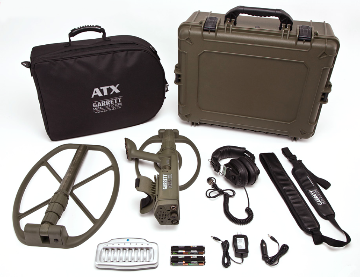 Garrett's new pulse induction ATX metal detector is the ultimate multi-frequency detector for all terrains and extreme conditions (highly mineralized ground, saltwater, etc.). It features advanced pulse induction technology, a durable design that meets military specifications, and an advanced 20 inch Deepseeker searchcoil is ideal for use in searching for caches and other deeply buried large objects. The ATX is waterproof to 10 feet. Garrett's new pulse induction ATX metal detector is the ultimate multi-frequency detector for all terrains and extreme conditions (highly mineralized ground, saltwater, etc.). It features advanced pulse induction technology, a durable design that meets military specifications, and an advanced 20 inch Deepseeker searchcoil is ideal for use in searching for caches and other deeply buried large objects. The ATX is waterproof to 10 feet.
PI (pulse induction) detectors work a bit differently than the more common VLF (very low frequency) detectors by putting magnetic field energy into the ground and then switching off and waiting a short period before they start to look for a response. This makes them better at handling ground mineralization than a VLF detector because during that short delay the magnetic response of iron trash minerals that you don't want to find dies out. VLF detectors do not as easily cancel out ground mineralization the way a PI metal detector can do.
Kevin Hoagland, Executive Director of Development for the Gold Prospectors Association of America recently field tested the Garrett ATX Deepseeker. Below is an excerpt of Kevin's review:
"My first impression of the ATX was that it's compact, heavy and built like a tank, and all connections are waterproof. Battery installation is simple. The ATX uses 8 AA batteries in two 4-battery drop-in packs and comes with an 8-slot AA battery charger. Not only does this detector come with a rugged case and carry bag, but also everything else you need to get out detecting. The units ships with the 20 inch mono coil already installed. It is also shipped with headphones that are screwed into the back of the unit.
I slipped my arm into the adjustable cuff, and grabbed the control pod. There was no unnecessary torque on  my wrist, which gave it a perfect fit and feel, and allowed me to work all of the control buttons easily with my thumb. I pushed the unit out in front of me a bit and turned on the power switch, which is located on the back of the unit. The Garrett ATX Deepseeker Metal Detector goes through its startup and self-diagnostic test. Every light on the control pad comes on and unit emits several different sounds before settling into a comfortable, but high, threshold. This is not a turn-on-and-go detector. Either read the entire owners manual before you go out hunting, or at least read the first two pages of the manual— page 1 is the Quick Start Guide and an explanation of how to access the functions of the ATX quickly, and page 2 shows you where to find more information concerning those functions. my wrist, which gave it a perfect fit and feel, and allowed me to work all of the control buttons easily with my thumb. I pushed the unit out in front of me a bit and turned on the power switch, which is located on the back of the unit. The Garrett ATX Deepseeker Metal Detector goes through its startup and self-diagnostic test. Every light on the control pad comes on and unit emits several different sounds before settling into a comfortable, but high, threshold. This is not a turn-on-and-go detector. Either read the entire owners manual before you go out hunting, or at least read the first two pages of the manual— page 1 is the Quick Start Guide and an explanation of how to access the functions of the ATX quickly, and page 2 shows you where to find more information concerning those functions.
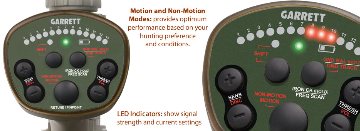 There are 5 major functions that are completely user-adjustable: Mode, Sensitivity, Threshold, Volume, and Ground Balance. Are functions are easy to adjust with a basic understanding of the ATX and more tunable as you become more proficient. Secondary functions include iron check, tracking, discrimmination and frequency shifting, to name only a few. There are 5 major functions that are completely user-adjustable: Mode, Sensitivity, Threshold, Volume, and Ground Balance. Are functions are easy to adjust with a basic understanding of the ATX and more tunable as you become more proficient. Secondary functions include iron check, tracking, discrimmination and frequency shifting, to name only a few.
As with most large PI detectors, the Garrett ATX Deepseeker Metal Detector is not light, and the waterproofing adds extra weight. Were it not for the ergonomic design, detectorists not accustomed to the weight of these machines might tire quickly. The supplied sling is easy to use, adjust, and offers a fair way to alleviate some of the weight, but I found it uncomfortable for long periods of use. Many avid detectorists use after-market harness systems, so you may want to check out those options if you plan to spend long days detecting.
In the field, the Deepseeker performed exceptionally well. The unit demonstrated almost complete immunity to all but the worst hot rocks I encountered. The ground balance and multi-speed ground tracking worked great, but I found that I rarely used the ground tracking as the ATX handled most of the soil mineralization in the OFF position. The threshold was quick to respond to ground changes and a simple ground balance was all that was needed to bring the ATX back into maximum depth and sensitivity. The Iron Check works well, maybe even too well! I dig everything no matter what and I have had a very successful nugget-hunting career doing just that. I have found good targets under junk on many occasions. Be careful and mindful that gold, like junk, is where you find it and there is no law of detecting that states there will be no gold under junk!
Regardless of your level of detecting expertise, it will take some time to get comfortable with all the functions and navigating the menus of the ATX. With multi-button presses to access some functions, it's important to take time to learn the machine well beyond the quick-start level. Overall, Garrett has created a PI detector that is extremely well made with solid functionality. The ATX offers great value for your dollar. Garrett has again carved a niche in the metal detector market, and the ATX perfectly has met the needs expressed by detectorists worldwide..."
You can find Kevin's complete field test review on pages 16-19 of the November/December 2014 issue of Gold Prospectors Magazine, or download the .pdf here. You can also get more information and watch a video of the Garrett ATX Deepseeker Metal Detector on this website.
|






 nuggets out of a crack in the bedrock.
nuggets out of a crack in the bedrock. 
 used in as well as the targets being sought. A change in any one of these variables may require a different searchcoil. Sometimes changing the search coil on your metal detector is the next best thing to buying a whole new machine! It is possible that merely changing the coil on your detector will lead you to a host of new targets.
used in as well as the targets being sought. A change in any one of these variables may require a different searchcoil. Sometimes changing the search coil on your metal detector is the next best thing to buying a whole new machine! It is possible that merely changing the coil on your detector will lead you to a host of new targets. significantly reduce ground interference and, thereby, recover the performance lost by a concentric coil over mineralized soil. With the Double-D, it is the arrangement of the TX and RX coils that produce a canceling effect of ground signals. This configuration is called DD because both TX and RX coils are in the shape of a “D”. The positive detection fi eld of the DD runs beneath the overlapping center section from front-to-back. The remaining portion of the coil actually produces negative (i.e. canceling) detection fields. It is this canceling field that allows the DD coil to maintain performance over mineralized ground. Because of its small positive detection field, the DD is inherently less sensitive than a concentric searchcoil of the same size, over non-mineralized ground. The Double-D will, however, significantly outperform the concentric coil over mineralized ground. For this reason, it is highly recommended when hunting over mineralized ground commonly found when prospecting and relic hunting.
significantly reduce ground interference and, thereby, recover the performance lost by a concentric coil over mineralized soil. With the Double-D, it is the arrangement of the TX and RX coils that produce a canceling effect of ground signals. This configuration is called DD because both TX and RX coils are in the shape of a “D”. The positive detection fi eld of the DD runs beneath the overlapping center section from front-to-back. The remaining portion of the coil actually produces negative (i.e. canceling) detection fields. It is this canceling field that allows the DD coil to maintain performance over mineralized ground. Because of its small positive detection field, the DD is inherently less sensitive than a concentric searchcoil of the same size, over non-mineralized ground. The Double-D will, however, significantly outperform the concentric coil over mineralized ground. For this reason, it is highly recommended when hunting over mineralized ground commonly found when prospecting and relic hunting.















 my wrist, which gave it a perfect fit and feel, and allowed me to work all of the control buttons easily with my thumb. I pushed the unit out in front of me a bit and turned on the power switch, which is located on the back of the unit. The Garrett ATX Deepseeker Metal Detector goes through its startup and self-diagnostic test. Every light on the control pad comes on and unit emits several different sounds before settling into a comfortable, but high, threshold. This is not a turn-on-and-go detector. Either read the entire owners manual before you go out hunting, or at least read the first two pages of the manual— page 1 is the Quick Start Guide and an explanation of how to access the functions of the ATX quickly, and page 2 shows you where to find more information concerning those functions.
my wrist, which gave it a perfect fit and feel, and allowed me to work all of the control buttons easily with my thumb. I pushed the unit out in front of me a bit and turned on the power switch, which is located on the back of the unit. The Garrett ATX Deepseeker Metal Detector goes through its startup and self-diagnostic test. Every light on the control pad comes on and unit emits several different sounds before settling into a comfortable, but high, threshold. This is not a turn-on-and-go detector. Either read the entire owners manual before you go out hunting, or at least read the first two pages of the manual— page 1 is the Quick Start Guide and an explanation of how to access the functions of the ATX quickly, and page 2 shows you where to find more information concerning those functions. There are 5 major functions that are completely user-adjustable: Mode, Sensitivity, Threshold, Volume, and Ground Balance. Are functions are easy to adjust with a basic understanding of the ATX and more tunable as you become more proficient. Secondary functions include iron check, tracking, discrimmination and frequency shifting, to name only a few.
There are 5 major functions that are completely user-adjustable: Mode, Sensitivity, Threshold, Volume, and Ground Balance. Are functions are easy to adjust with a basic understanding of the ATX and more tunable as you become more proficient. Secondary functions include iron check, tracking, discrimmination and frequency shifting, to name only a few.